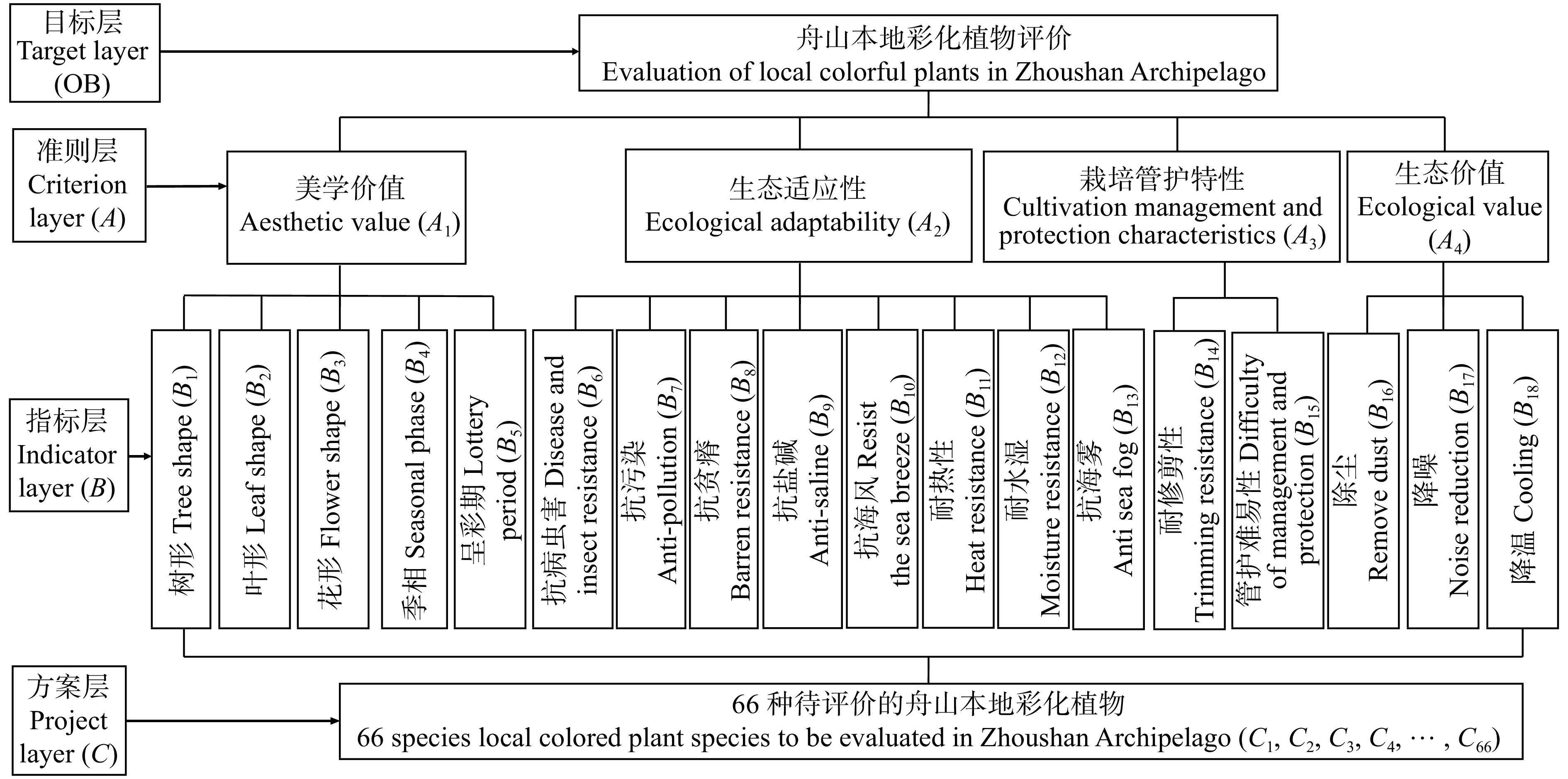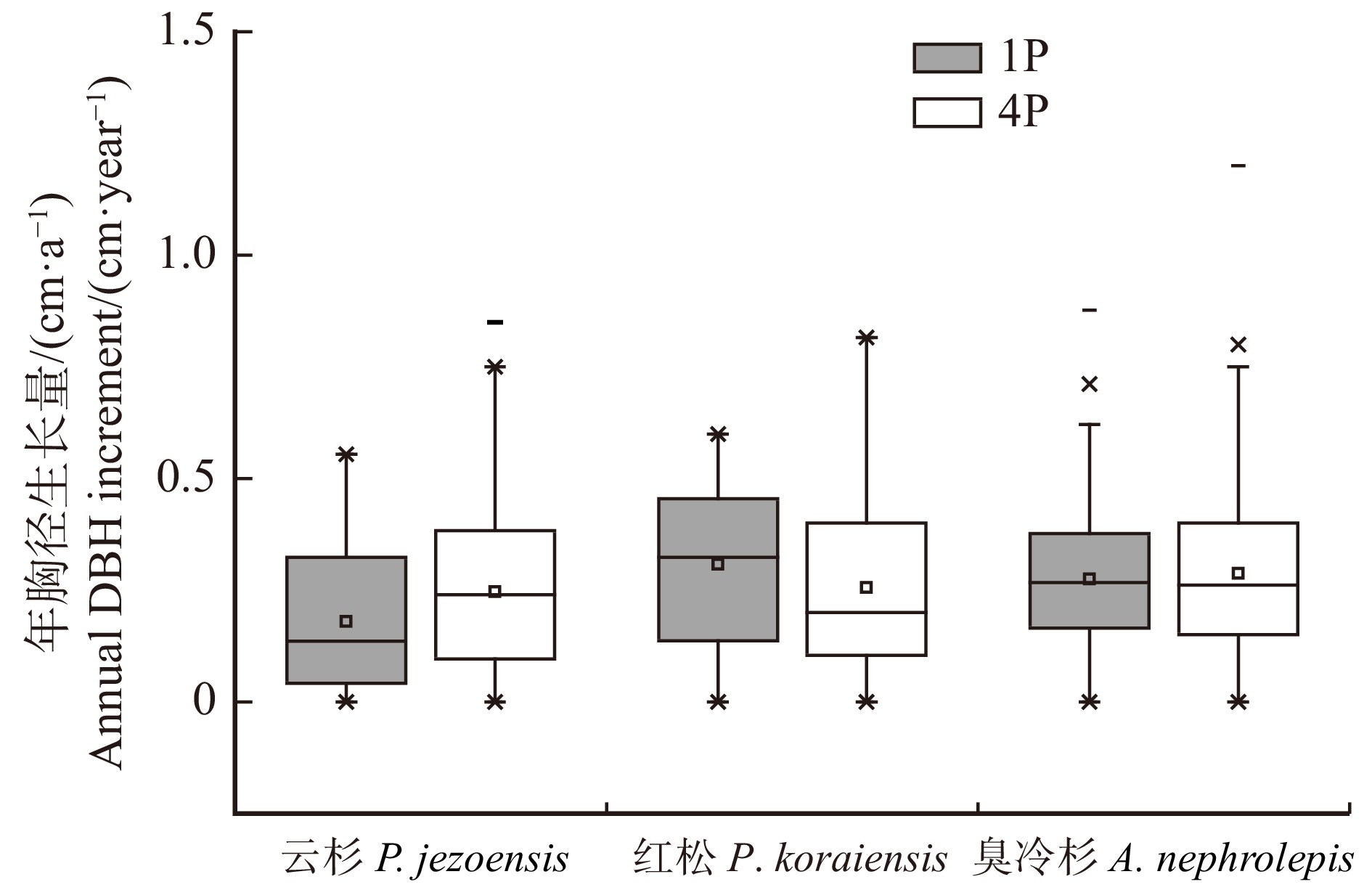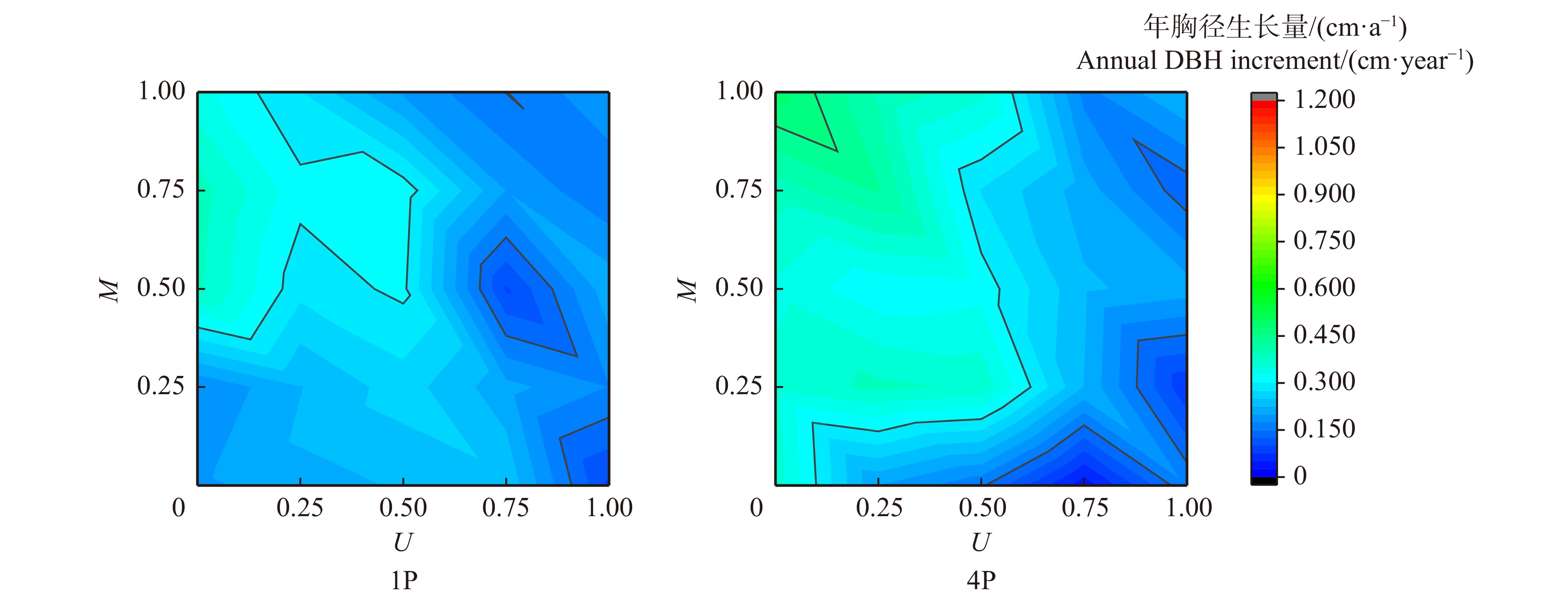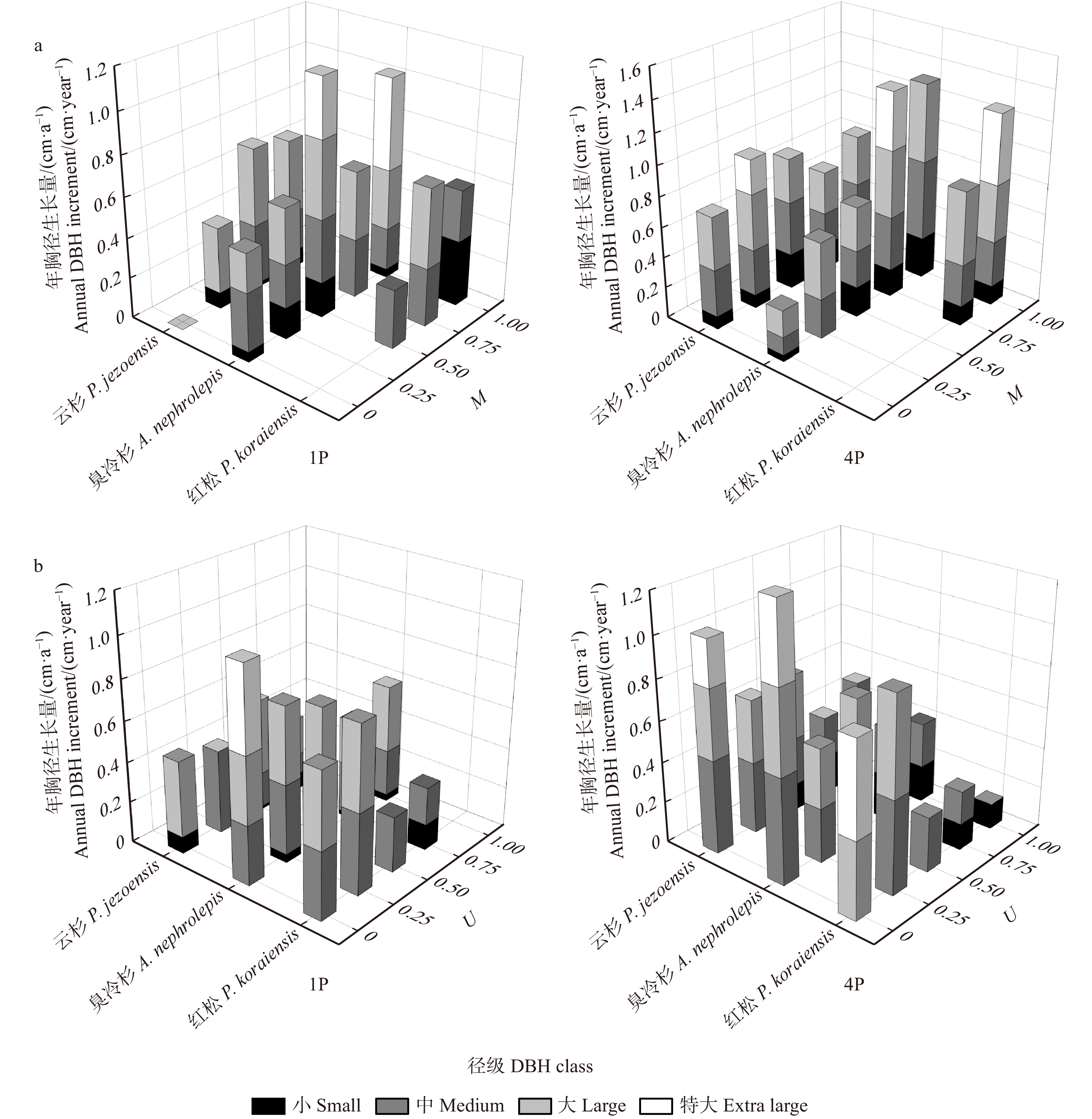Relationship between stand spatial structure and DBH increment of principal species in natural spruce-fir mixed forest in Changbai Mountains of northeastern China
-
摘要:目的 混交林的稳定性、发展的可能性与空间结构密切相关,探究空间结构对林分生长量的影响对促进林分良性发展有着重要作用。本研究以天然云冷杉针阔混交林为对象,分析混交度(M)和大小比数(U)对单木生长量的影响,以期为该地区天然林林分结构调整提供科学依据和指导。方法 选用2块云杉蓄积占总蓄积比例分别为0.1~0.2(1成云,1P)和0.4(4成云,4P)固定样地的5期监测数据,采用4株相邻木法计算空间结构三参数,绘制多元分布图,分析了1P和4P内各径级云杉、臭冷杉和红松在不同混交度和大小比数的胸径生长量变化规律。结果 1P和4P均介于中度和强度混交(M分别为0.625和0.657)且呈随机分布;臭冷杉和红松的生长介于亚优势至中庸状态间(U = 0.25 ~ 0.50),云杉在4P内介于亚优势至中庸状态间(U = 0.48),在1P内介于中庸至劣势状态间(U = 0.70)。云杉和臭冷杉的年胸径生长量随径级的增大而增大(P < 0.05);随对象木混交度的增大而增大,其中小径级云杉和大中小径级臭冷杉与混交度呈显著相关(P < 0.05);云杉、臭冷杉和红松的年胸径生长量随对象木大小比数的增大而减小,其中中径级木与大小比数呈显著相关(P < 0.05)。云杉在1P内的年胸径生长量低于4P,红松相反。结论 不同径级下林木的生长具有显著差异,降低大小比数的同时适当提高混交度有利于林木的胸径生长。不同生长阶段的竞争不同导致了不同径级林木对混交度和大小比数响应的差异,故针对不同生长阶段的林木应采取不同的经营措施调整优化林分结构,促进林分长期的稳定发展。Abstract:Objective The stability and development possibility of mixed forest are closely related to its spatial structure. Exploring the influence of spatial structure on stand growth plays an important role in promoting the benign development of forest.Method Based on the 5 periods of monitoring data of two fixed sample plots, the proportion of spruce (Picea jezoensis) accumulation in the sample plot was 0.1−0.2 and 0.4, respectively, which were recorded as 1P and 4P. The three parameters of spatial structure were calculated by 4 adjacent tree methods, and the multivariate distribution map was drawn. The changes of DBH increment of spruce, fir (Abies nephrolepis) and Korean pine (Pinus koraiensis) under different diameter classes, mingling degrees and neighborhood comparison in 1P and 4P were compared and analyzed.Result 1P and 4P were both medium and strong mixed (M was 0.625 and 0.657, respectively) and randomly distributed. The growth of fir and Korean pine was between sub-dominant state and median state (U = 0.25 − 0.50), the growth of spruce was between sub-dominant state and median state (U = 0.48) in 1P, and was between median state and inferior state in 4P (U = 0.70). The annual DBH increment of spruce and fir increased with the increase of DBH class (P < 0.05) and the mingling degree of subject trees, and the DBH increment of small-diameter spruce and large, medium and small diameter’s fir was significantly correlated with mingling degree (P < 0.05). The annual DBH increment of spruce, fir and Korean pine decreased with the increase of subject trees’ neighborhood comparison, and the correlation between the DBH increment of mid-diameter tree and dominance was significant (P < 0.05). The annual DBH increment of spruce in 1P was lower than that in 4P cloud, while that of Korean pines was opposite.Conclusion There are significant differences in the growth of trees under different diameter classes. Reducing the neighborhood comparison and appropriately increasing the mingling are beneficial to the DBH growth of trees. The competition in different growth stages leads to the difference in the response of different diameter classes to mingling degree and neighborhood comparison. Therefore, different management measures should be taken to adjust and optimize the stand structure to promote the long-term stable development of stand.
-
Keywords:
- spruce-fir forest /
- DBH increment /
- spatial structure /
- DBH class /
- neighborhood comparison /
- mingling degree
-
城市生态文明建设是国家生态文明战略的重要组成部分。随着城市生态文明建设事业的快速发展,建成区绿地在绿量和绿视率方面成效显著,大众对城市绿地景观的要求和审美水平也在不断提高。植物及其形成的景观是城市生态文明的重要体现,当前城市生态系统中,植物占据极其重要地位,承担着改善城市人居环境、丰富植物多样性[1-2]、维持城市生态系统稳定等功能。现如今,城市绿地建设已不仅单纯满足于对绿量追求,而且更加重视植物景观质量的提升,植物景观的色彩变化和特色主题营造已成为当前城市绿地建设发展的新趋势[3]。
我国植物资源丰富,可作为园林应用的潜在树木种类就达8 000种以上,而草本植物资源更加丰富,对提高我国城市绿地生物多样性具有先天的资源优势[3-4]。近年来,我国相关专家学者对植物资源调查和开发利用愈发关注[5-12],特色珍稀植物资源的开发[13]和推广应用的力度不断加大[5,14-19],对特色植物资源调查、筛选、评价体系构建[20-21],以及资源开发和园林应用一直是学者们和园林行业从业者的研究热点和关注焦点[22-28]。随着国家生态文明战略的确立和不断深入发展,城市绿地的彩化、香化、特色化等高品质化的诉求不断增强。在众多植物资源中,具有鲜明特色[29-31]尤其是具有较高彩化价值的本地特色植物资源颇受关注[32]。舟山群岛因其独特于内陆的海岛特征、地理位置和气候差异,分布着丰富的海岛特色彩化植物资源,有待开发生产和推广应用[33]。因此,对舟山海岛彩化植物资源进行全面调查、筛选、客观评价,为其推广应用奠定良好的基础,可为舟山的城市绿地彩化建设,以及舟山海岛特色的园林植物资源开发利用提供基础资料和理论评价依据,为我国植物资源开发和应用提供参考。
1. 研究地概况和研究对象界定
1.1 研究地概况
舟山群岛位于长江口南测、杭州湾外缘的东海海域,由嵊泗列岛、马鞍列岛、崎岖列岛、川湖列岛、中街山列岛、浪岗山列岛、七姊八妹列岛、火山列岛和梅散列岛组成。地理坐标介于121°30′ ~ 123°25′ E,29°32′ ~ 31°04′ N。东濒太平洋,南接象山县海界,西临杭州湾,北与上海市海界相接。境域东西长182 km,南北宽169 km,总面积2.22万 km2,其中海域面积2.08万 km2。舟山群岛是由3 190余个海岛组成的我国第一大群岛[34],是我国重点海洋旅游区域和国家旅游综合改革试点城市[35],同时确立了打造“海上花园城市”的生态发展目标 [36]。
1.2 研究对象界定
植物景观彩化是指根据植物生物学特性,利用不同植物的花、叶、果、皮等色相差异、季相变化、空间结构、视觉效果的变化,通过植物配置,产生美感的活动过程[37]。根据《城市园林绿化评价标准》的定义,本地植物是指:原有天然分布或长期生长于本地,适应本地自然条件并融入本地自然生态系统,对本地原生生物物种和生物环境不产生威胁的植物。主要包括:本地自然生长的野生植物及其衍生品种、归化种(非本地原生,但已逸为野生)及其衍生品种、驯化种(非本地原生,但在本地正常生长,并且完成其生活史的植物种类)及其衍生品种[38]。因此,舟山本地彩化植物是指原产舟山本地或者已成为舟山归化、驯化的植物种类或品种,是花、叶、果、枝(皮)长年具有除绿色外的长年或季节性的色彩变化的一类植物统称。
2. 研究方法
2.1 调查范围以及筛选方法
本研究对舟山市域范围内的城市建成区绿地和主要海岛天然植被进行实地调查,通过采集标本、拍照等方法记录植物的相关信息,并查阅《浙江植物志》以及相关文献进行考证[39],结合以下6个原则筛选出具有园林应用前景的66种舟山本地彩化植物。
2.2 筛选原则
2.2.1 舟山本地植物且有色彩或色彩变化
原有自然分布或长期生长于舟山本地,适应本地自然条件并融入本地自然生态系统,对本地原生环境不产生威胁的植物。这类植物的花、叶、果或枝等部位常年或者在特定的季节呈现出绿色以外的色彩。
2.2.2 有一定的苗木资源或具有开发价值
筛选出的植物在舟山市内外有较丰富的苗木资源,或者目前虽尚未有苗圃生产,但其本身的观赏价值及生态习性具备舟山城市园林绿地的应用潜力,且具有较大的开发价值的种类,如芫花(Daphne genkwa)、普陀狗娃花(Aster arenarius)、长萼瞿麦(Dianthus longicalyx)等。
2.2.3 适应性强且观赏价值较高
具有较好的适应性,如耐盐碱、抗海风、抗海雾、耐瘠薄、抗病虫害、耐水湿等特点。此外具有独特的观赏价值,如花色、叶色或果色鲜艳奇特,如黄连木(Pistacia chinensis)等。
2.2.4 具有舟山的历史文化寓意和特色
舟山历史悠久,作为我国重要的佛教圣地,宗教文化底蕴深厚,部分植物具有典型的佛教文化寓意,如南京椴(Tilia miqueliana)、石蒜(Lycoris radiate)等植物。
2.2.5 有一定数量的古树资源分布
古树指在舟山本地生长百年以上的树木,能在舟山生长百年以上,说明其已适应了舟山的气候和环境,如银杏(Ginkgo biloba)等。
2.2.6 舟山海岛地域特色、特有种类
特有植物是舟山地域植物景观特色的重要体现,如舟山新木姜子(Neolitsea sericea)、匙叶紫菀(Aster spathulifolius)等,这类植物的规模化生产和应用有助于形成舟山的地域植物景观特色。
2.3 AHP层次评价法
本研究运用AHP综合评价法对筛选出的66种本地彩化植物进行评价。根据舟山本地彩化植物的特点,征求风景园林、林学等方面的专家以及园林行业的工作者的意见和建议的基础上,通过调查问卷和专家打分的形式,确定了基本能够全面衡量和评价彩化植物在舟山应用的18个评价指标,根据其隶属关系,建立客观、合理的层次评价模型。
2.3.1 构建层次模型
模型包括目标层OB(舟山本地彩化植物综合评价)、准测层A(美学价值、生态适应性、栽培管护特性、生态价值)、指标层B(树形、叶形、花形数等18个综合评价舟山本地彩化植物应用的因素)、方案层C(待评价的彩化植物),各层次之间互不相交(图1)。
2.3.2 判断矩阵的构建及权重的确定
根据总目标的要求,在参考有经验的园林专业人士意见的基础上做出判断。本模型以1~9标度法构造判断矩阵,由此得出OB-A(第二层因素相对于第一层的比较判断)、A-B(第三层因素相对于第二层的比较判断)共5个矩阵。相关公式如下:
CI=(λmax (1) {\rm{CR = CI/RI}} (2) 式中:CI为一致性指标,λmax为判断矩阵相应行列式的非零最大特征根,CR为随机一致性比率,RI为判断矩阵的平均随机一致性指标。
其中,1~9阶的判断矩阵的RI值分别为0、0、0.52、0.89、1.12、1.26、1.36、1.41和1.46。作一致性的检验,需计算CI然后将CI与RI进行相互比较计算CR,若CR < 0.1,则判断该矩阵具有满意的一致性[40]。根据迈实软件(Version1.82)完成相应的计算与检验,该软件可生成相应的专家调查表格,并可实现数据的批量处理,具有较强的实用性与数据可靠性。
2.3.3 评分标准建立
本研究的评价人员均为有相关知识背景和实践经验的专业人员,对舟山本地彩化植物具有良好的认知和评判能力[40]。采用5分评分标准邀请参评人员评价标准层指标,计算得出总分,从而进行分级评价(表1)。最终得出各植物18个指标的得分Ci(i = 1, 2, ···, 18)。同时采用层次分析法和加权平均法获得各影响因素的平均权重(Wi),运用以下公式计算各植物的综合评价值(Tj)。
表 1 舟山本地彩化植物评价指标和评价标准Table 1. Evaluation indexes and standards of local colourful plants in Zhoushan Archipelago评价指标 Evaluation index 分值(0~5) Score(0−5) A1 B1
B2树形差、松散至树形美、紧凑
From poor tree shape, loose to beautiful tree shape, compact叶小、形差、松散至叶大、形美、紧密
From small leaf, poorly shaped, loose to large, beautiful and compactB3 花小、花少、花色单一至花大、花多、花色丰富
From small flower, few flower, single color to large flower, many flower, and rich colorB4 叶色变化单一至叶色变化丰富
Leaf color changes from single to richB5 15 d以下、16 ~ 20 d、21 ~ 25 d、25 ~ 30 d、30 d以上
Less than 15 d, 16−20 d, 21−25 d, 25−30 d and more than 30 dA2 B6 差、较差、中等、较强、强
Poor, inferior, middle, stronger, strongestB7 B8 B9 B10 B11 B12 B13 A3 B14 差、较差、中等、较强、强
Poor, inferior, middle, stronger, strongestB15 A4 B16 差、较差、中等、较强、强
Poor, inferior, middle, stronger, strongestB17 B18 {\rm{Tj}} = \sum {{C_i}{W_i}} (3) 2.3.4 权重分析及一致性检验
对4个判断矩阵进行一致性检验。当判断矩阵的CR < 0.1时或CI = 0时,认为判断矩阵具有满意的一致性,否则需调整矩阵中的元素以使其具有满意的一致性。
3. 结果和分析
3.1 评价模型权重设置及评价结果分析
评价因子的权重体现出该指标在评价中的相对重要性,确定各指标权重是评价的前提[40]。此处采用1~9比率标度法,对层次模型构造判断矩阵,并进行层次单类别和一致性检验以及层次总类别和一致性检验[40]。由表2、3、4、5可知:乔木、灌木、草本、藤本等4类植物CR值分别为0.031、0.087、0.013、0.066,均小于0.1一致性检验均通过。对其他3类评价模型依次计算检验,均得到满意的一致性,最终确定不同的评价指标权重[40]。在各项评分的基础上按各项得分与其权重进行计算,求得各自的综合得分,根据不同的生活型将66种彩化植物划分为3个等级:Ⅰ类(Tj ≥ 3.5)、Ⅱ类(3.5 > Tj ≥ 3.0)、Ⅲ类(Tj < 3.0)。
表 2 乔木评价模型判断矩阵及一致性检验Table 2. Judgment matrix and consistency test of tree evaluation model项目 Item A1 A2 A3 A4 Wi A1 1.000 1.000 5.000 7.000 0.452 A2 1.000 1.000 3.000 5.000 0.366 A3 0.200 0.333 1.000 3.000 0.124 A4 0.143 0.200 0.333 1.000 0.058 注:乔木评价模型中,舟山本地彩化植物综合评价OB-Ai,其中λmax = 4.082,CR = 0.031, CI = 0.027。Notes: in the arbor evaluation model, the comprehensive evaluation of Zhoushan Archipelago local colorful plants is OB-Ai, in which, λmax = 4.082, CR = 0.031, CI = 0.027. 表 3 灌木评价模型判断矩阵及一致性检验Table 3. Judgment matrix and consistency test of shrub evaluation model项目 Item A1 A2 A3 A4 Wi A1 1.000 1.000 3.000 7.000 0.417 A2 1.000 1.000 5.000 3.000 0.383 A3 0.333 0.200 1.000 3.000 0.130 A4 0.143 0.333 0.333 1.000 0.069 注:灌木评价模型中,舟山本地彩化植物综合评价OB-Ai,其中λmax = 4.233,CR = 0.087, CI = 0.078。Notes: in the shrub evaluation model, the comprehensive evaluation of Zhoushan Archipelago local colorful plants is OB-Ai, in which, λmax = 4.233, CR = 0.087, CI = 0.078. 表 4 藤本评价模型判断矩阵及一致性检验Table 4. Judgment matrix and consistency test of liana evaluation model项目 Item A1 A2 A3 A4 Wi A1 1.000 1.000 5.000 7.000 0.343 A2 1.000 1.000 1.000 9.000 0.294 A3 0.200 1.000 1.000 7.000 0.218 A4 0.143 0.111 0.143 1.000 0.145 注:藤本植物评价模型中,舟山本地彩化植物综合评价OB-Ai,其中λmax = 4.343,CR = 0.013,CI = 0.114。Notes: in the liana evaluation model, the comprehensive evaluation of Zhoushan Archipelago local colorful plants is OB-Ai, in which, λmax = 4.343, CR = 0.013, CI = 0.114. 表 5 草本评价模型判断矩阵及一致性检验Table 5. Judgment matrix and consistency test of herb evaluation model项目 Item A1 A2 A3 A4 Wi A1 1.000 0.333 1.000 9.000 0.239 A2 1.000 1.000 3.000 7.000 0.512 A3 1.000 0.333 1.000 5.000 0.206 A4 0.111 0.143 0.200 1.000 0.043 注:草本植物评价模型中,舟山本地彩化植物综合评价OB-Ai,其中λmax = 4.175,CR = 0.066,CI = 0.058。Notes: in the herbaceous plant evaluation model, the comprehensive evaluation of Zhoushan Archipelago local colorful plants is OB-Ai, where λmax = 4.175, CR = 0.066, CI = 0.058. 3.2 乔木综合评价结果
30种舟山本地彩化乔木综合评价结果如表6所示:30种彩化乔木中评价为Ⅰ类的有黄连木(Pistacia chinensis)、舟山新木姜子(Neolitsea sericea)2种,占比6.7%;评价为Ⅱ类的有海滨木槿(Hibiscus hamabo)、枫香(Liquidambar formosana)、白杜(Euonymus maackii)、全缘冬青(Ilex integra)、海州常山(Clerodendrum trichotomum)、野鸦椿(Euscaphis japonica)、乌桕(Sapium sebiferum)、檫木(Sassafras tzumu)、铁冬青(Ilex rotunda)、南川柳(Salix rosthornii)、七叶树(Aesculus chinensis)等11种,占比36.7%。综合评价为Ⅰ类和Ⅱ类的乔木,建议作为舟山园林绿地的基调植物,并作为主要苗木产品在舟山本地苗圃进行生产和应用。
表 6 舟山本地彩化乔木综合评价值Table 6. Comprehensive evaluation values of local colorful trees in Zhoushan Archipelago类别 Category 植物名
Plant name分值 Score 类别 Category 植物名
Plant name分值 Score Ⅰ 黄连木 Pistacia chinensis 3.848 Ⅲ 冬青 Ilex chinensis 2.874 Ⅰ 舟山新木姜子 Neolitsea sericea 3.530 Ⅲ 金银木 Lonicera maackii 2.755 Ⅱ 海滨木槿 Hibiscus hamabo 3.422 Ⅲ 无患子 Sapindus mukorossi 2.712 Ⅱ 枫香 Liquidambar formosana 3.372 Ⅲ 榔榆 Ulmus parvifolia 2.699 Ⅱ 白杜 Euonymus maackii 3.372 Ⅲ 豆梨 Pyrus calleryana 2.681 Ⅱ 全缘冬青 Ilex integra 3.329 Ⅲ 合欢 Albizzia julibrissin 2.681 Ⅱ 海州常山 Clerodendrum trichotomum 3.221 Ⅲ 小叶石楠 Photinia parvifolia 2.666 Ⅱ 野鸦椿 Euscaphis japonica 3.199 Ⅲ 柿树 Diospyros kaki 2.653 Ⅱ 乌桕 Sapium sebiferum 3.159 Ⅲ 南京椴 Tilia miqueliana 2.639 Ⅱ 檫木 Sassafras tzumu 3.151 Ⅲ 山茱萸 Cornus officinale 2.615 Ⅱ 铁冬青 Ilex rotunda 3.132 Ⅲ 朴树 Celtis sinensis 2.545 Ⅱ 南川柳 Salix rosthornii 3.076 Ⅲ 榉树 Zelkova schneideriana 2.503 Ⅱ 七叶树 Aesculus chinensis 3.062 Ⅲ 金钱松 Pseudolarix amabilis 2.453 Ⅲ 三角枫 Acer buergerianum 2.947 Ⅲ 银杏 Ginkgo biloba 2.326 Ⅲ 红楠 Machilus thunbergii 2.946 Ⅲ 红椿 Toona ciliata 2.324 3.3 灌木综合评价结果
对筛选出的16种备选灌木进行综合评价,结果显示(表7):综合评价为Ⅰ类的彩化植物有白棠子树(Callicarpa dichotoma)、芫花(Daphne genkwa)、蜡梅(Chimonanthus praecox)、美丽胡枝子(Lespedeza formosa)、老鸦糊(Callicarpa giraldii)等,占比31.3%;评价为Ⅱ类的有浙江红山茶(Camellia chekiangoleosa)、中华绣线菊(Spiraea chinensis)、河北木蓝(Indigofera bungeana)、紫珠(Callicarpa bodinieri)、紫金牛(Ardisia japonica)、卫矛(Euonymus alatus)、金钟花(Forsyfhia viridissima)、溲疏(Deutzia crenata)、臭牡丹(Clerodendrum bungei)等9种,占比56.3%。这2大类植物建议在舟山园林绿地中推广应用,尤其是第Ⅰ类建议扩大苗木生产。
表 7 舟山本地彩化灌木综合评价值Table 7. Comprehensive evaluation values of local colorful shrubs in Zhoushan Archipelago类别 Category 植物名
Plant name分值 Score 类别 Category 植物名
Plant name分值 Score Ⅰ 白棠子树 Callicarpa dichotoma 3.789 Ⅱ 中华绣线菊 Spiraea chinensis 3.272 Ⅰ 芫花 Daphne genkwa 3.669 Ⅱ 河北木蓝 Indigofera bungeana 3.133 Ⅰ 蜡梅 Chimonanthus praecox 3.651 Ⅱ 紫珠 Callicarpa bodinieri 3.115 Ⅰ 美丽胡枝子 Lespedeza formosa 3.532 Ⅱ 紫金牛 Ardisia japonica 3.082 Ⅰ 老鸦糊 Callicarpa giraldii 3.504 Ⅱ 卫矛 Euonymus alatus 3.078 Ⅱ 浙江红山茶 Camellia Chekiangoleosa 3.449 Ⅱ 金钟花 Forsyfhia viridissima 3.061 Ⅱ 溲疏 Deutzia crenata 3.346 Ⅲ 紫荆 Cercis chinensis 2.888 Ⅱ 臭牡丹 Clerodendrum bungei 3.279 Ⅲ 朱砂根 Ardisia crenata 2.885 3.4 藤本综合评价结果
对筛选出的舟山本地5种本地藤本植物进行综合评价,结果如表8所示:评价为Ⅰ类的有单叶蔓荆(Vitex trifolia)和地锦(Parthenocissus tricuspidata)2种,占比40%;综合评价为Ⅱ类的有紫藤(Wisteria sinensis)和云实(Caesalpinia decapetala)2种,占比40%。这2类藤本植物均具有较好的开发应用潜力,可加大其在舟山城市园林绿地的推广和应用。
表 8 舟山本地彩化藤本综合评价值Table 8. Comprehensive evaluation values of local colorful vines in Zhoushan Archipelago类别 Category 植物名
Plant name分值 Score Ⅰ 单叶蔓荆 Vitex trifolia 3.872 Ⅰ 地锦 Parthenocissus tricuspidata 3.545 Ⅱ 紫藤 Wisteria sinensis 3.218 Ⅱ 云实 Caesalpinia decapetala 3.081 Ⅲ 忍冬 Lonicera japonica 2.908 3.5 草本综合评价结果
舟山本地草本植物评价结果显示(表9):在15种舟山本地多年生草本中,匙叶紫菀(Aster spathulifolius)、芙蓉菊(Crossostephium chinense)、普陀狗娃花(Heteropappus arenarius)、八宝景天(Hylotelephium erythrostichum)、大吴风草(Farfugium japonicum)、佛甲景天(Sedum lineara)综合评价最好,占比40.0%;长萼瞿麦(Dianthus chinensis)、赤胫散(Polygonum runcinatum var. sinense)评价次之,占比13.3%。综合评价表明,这2类植物具有较高的开发和应用价值,建议在舟山对其加以重点推广和开发应用。
表 9 舟山本地彩化草本综合评价值Table 9. Comprehensive evaluation values of local colorful herbs in Zhoushan Archipelago类别 Category 植物名
Plant name分值
Score类别 Category 植物名
Plant name分值 Score Ⅰ 匙叶紫菀 Aster spathulifolius 4.353 Ⅲ 虎耳草 Saxifraga stolonifera 2.926 Ⅰ 芙蓉菊 Crossostephium chinense 4.327 Ⅲ 石蒜 Lycoris radiate 2.715 Ⅰ 普陀狗娃花 Heteropappus arenarius 3.852 Ⅲ 换锦花 Lycoris sprengeri 2.715 Ⅰ 八宝景天 Hylotelephium erythrostichum 3.804 Ⅲ 普陀水仙 Narcissus tazetta 2.579 Ⅰ 大吴风草 Farfugium japonicum 3.617 Ⅲ 射干 Belamcanda chinensis 2.526 Ⅰ 佛甲景天 Sedum lineara 3.611 Ⅲ 白及 Bletilla striata 2.490 Ⅱ 长萼瞿麦 Dianthus chinensis 3.337 Ⅲ 桔梗 Platycodon grandiflorus 2.244 Ⅱ 赤胫散 Polygonum runcinatum var. sinense 3.334 4. 结论和讨论
4.1 评价结果
通过调查可知,舟山群岛本地彩化植物资源丰富,地域特色鲜明,彩化植物资源推广应用和开发空间和潜力巨大[30]。根据评价结果可知:综合评分为Ⅰ类的彩化植物共15种,乔木如黄连木、舟山新木姜子;灌木如芫花、蜡梅、白棠子树、美丽胡枝子、老鸦糊等;藤本植物如单叶蔓荆和地锦;草本植物如匙叶紫菀、芙蓉菊、普陀狗娃草、八宝景天、大吴风草、佛甲景天等。这15种本地彩化植物在美学价值、生态适应性、栽培管护特性、生态价值(效益)方面综合评价最高,具有极高的开发价值,是舟山城市彩化建设中值得推广应用的本地彩化植物资源,建议对该类植物加强繁育,扩大苗木资源。
综合评价为Ⅱ类的彩化植物共24种,乔木如海滨木槿、枫香、白杜、全缘冬青、海州常山、野鸦椿、乌桕、檫木、铁冬青、南川柳、七叶树等;灌木如中华绣线菊、河北木蓝、紫珠、紫金牛、卫矛、金钟花、浙江红山茶、溲疏、臭牡丹等;藤本植物如紫藤和云实;草本植物如长萼瞿麦和赤胫散。这些彩化植物在在美学价值、生态适应性、栽培管护特性、生态价值(效益)方面综合评价相对较高,具有较好的开发前景,建议以开发和推广应用,以丰富城市植物景观色彩和彩化植物多样性。
综合评价为Ⅲ类的彩化植物共27种,乔木15种,如三角枫、冬青、金银木、无患子、榔榆等;灌木如紫荆、朱砂根;藤本植物如有忍冬;草本植物如虎耳草、石蒜、换锦花等,这类彩化植物综合评价相对较低,但在丰富城市色彩和彩化植物多样性方面亦可以发挥一定的作用。
因此,综合评价为Ⅰ类的15种彩化植物和Ⅱ类的24种彩化植物,可作为丰富舟山城市色彩或彩化植物多样性的补充彩化植物资源加以重点开发和利用。由于舟山土地资源紧张,本研究评价结果可作为生产和应用提供参考和借鉴,向长三角土地资源丰富的地区推广生产和应用。
4.2 舟山本地彩化植物应用存在的问题
通过与内陆地区彩色植物资源比较[29,31-32,41-42]可知:舟山群岛彩化植物资源的海岛特征明显,与内陆地区彩化植物资源有一定的差异,尤其是舟山特有植物资源,如舟山新木姜子、匙叶紫菀、普陀狗娃花、普陀水仙(Narcissus tazetta)、芙蓉菊等,还分布有海滨木槿、全缘冬青、长萼瞿麦、单叶蔓荆等典型的海岛植物资源。但当前舟山建成区城市绿地中,道路绿化主要行道树为香樟(Cinnamomum camphora)、广玉兰(Magnolia grandiflora)、红楠等常绿植物,其中香樟行道树占比95%以上[1],植物景观色彩单一,缺乏季相色彩变化。悬铃木(Platanus acerifolia)、朴树、紫薇(Lagerstroemia indica)、无患子、银杏等,具有一定的色彩变化的植物占比较少,约5%[1]。基于现状的调研,城市公园绿地中常见本地彩化植物约20余种,主要有舟山新木姜子、乌桕、黄连木、海滨木槿、红楠、合欢、全缘冬青、朴树、榉树、枫香、铁冬青、大叶冬青、冬青、紫金牛、朱砂根、大吴风草、榔榆、丝棉木(白杜)、三角枫,约占本次筛选数量的30%。需要说明的是,调查中发现以上彩化植物大多只是零星应用在公园绿地中,体量较小,并未形成植物景观彩化基调,尚不能体现舟山城市绿地的植物景观特色。通过调研发现主要有以下原因:(1)舟山土地资源紧张,难以大规模生产本地彩化植物资源,致使本地特色鲜明的彩化植物难以得到较好的生产推广;(2)随着舟山城市建设的快速推进,城市园林绿地建设周期短、工期紧,在舟山本地绿地建设中,外来园林景观规划设计单位居多,对舟山本地彩化植物苗木资源的了解尚不够深入,在设计阶段主要还是以外来的常规苗木为主,进一步导致本地植物的生产开发和园林应用推广受到限制;(3)本地彩化植物资源的研究、苗木生产和推广力度总体偏弱,尚需加强。
4.3 建议和对策
目前,舟山市城市园林绿地“绿化有余、彩化不足”的问题也日渐显现,单一传统的绿化形式以及单纯的对绿量的追求已很难体现作为旅游型城市建设水平,难以满足市民和游客的审美需求[37]。园林植物作为舟山城市园林绿地建设的核心要素,在本地彩化植物资源中发挥着关键作用。微观层面上是对本地彩化植物资源进行评价和开发,并进行资源调查和综合评价,为舟山市本地彩化植物资源引种驯化研究、苗木生产和推广应用工作建立提供了研究基础,有利于促进本地彩化植物在舟山城市绿地建设中应用的良性循环。宏观层面上建议加强对建成区的绿地本地彩化植物景观的总体顶层规划研究,对城市绿地加强顶层的植物景观总体规划,目的是为对今后的城市园林彩化建设起到宏观层面的系统指导作用。一方面,城市绿地的品质提高有利于促进舟山群岛新区旅游业及其他行业的可持续发展;另一方面,由过去的“城市绿化”升级为的“城市彩化”的建设目标,不断将舟山城市生态文明建设和“海上花园城市”建设推向新高度,有利于提升舟山城市的品味,增强市民的获得感和幸福感。
致谢 本研究得到浙江农林大学风景园林与建筑学院吴仁武博士,以及李上善、张明月、朱怀真等硕士研究生的大力支持和帮助,在此一并表示感谢。
-
图 2 1P和4P样地内树种、空间结构参数和径级的多元分布
M.混交度;U.大小比数。小.6 ~ 12 cm径阶;中.14 ~ 24 cm径阶;大.26 ~ 36 cm径阶;特大.38 cm 以上径阶。下同。M, mingling degree; U, neighborhood comparison. Small, 6−12 cm DBH grade; medium, 14−24 cm DBH grade; large, 26−36 cm DBH grade; extra, larger than 38 cm DBH grade. The same below.
Figure 2. Multivariate distribution of spatial structure parameters, tree species and DBH class in 1P and 4P
表 1 云冷杉固定样地情况及云杉比例
Table 1 Statistic of spruce-fir fixed sample plots and spruce proportion
样地类型
Sample plot type面积/hm2
Area/ha海拔
Altitude/m坡向
Slope aspect坡度
Slope degree/(°)调查年份
Survey year平均
胸径
Mean DBH/cm密度/(株·hm−2)
Density/(tree·ha−1)断面积/(m2·hm−2)
Basal area/
(m2·ha−1)树种组成
Species composition1P 0.200 700 西北 Northwest 8 1998 20.0 795 25.1 7A1P1PK1B 2001 20.4 775 25.4 2003 20.8 785 26.8 2006 21.7 755 27.8 6A2P1PK1B 2008 22.2 760 29.4 6A1P1PK1B + BC 4P 0.312 780 东北 Northeast 10 2000 19.7 929 28.4 4A4P1PK1BC 2002 19.8 875 26.9 2004 20.6 852 28.2 2006 21.1 830 28.9 2008 21.6 810 29.7 注:P.云杉;A.臭冷杉;PK.红松;B.白桦;BC.枫桦;1P和4P分别代表云杉树种组成占1到2成和4成的样地。下同。Notes: P, Picea jezoensis; A, Abies nephrolepis; PK, Pinus koraiensis; B, Betula platyphylla; BC, Betula costata; 1P and 4P stand for sample plots with the species composition of P. jezoensis being 1 to 2 or 4. The same below. 表 2 不同径级林木年胸径生长量 cm/a
Table 2 Annual DBH increment among different DBH classes
cm/year 树种
Tree species样地类型
Sample plot type径级 DBH class 小 Small 中 Medium 大 Large 特大 Extra large 云杉
P. jezoensis1P 0.08 ± 0.06a 0.18b ± 0.13b 0.37 ± 0.09c − 4P 0.14 ± 0.13a 0.25 ± 0.20b 0.32 ± 0.17c − 臭冷杉
A. nephrolepis1P 0.11 ± 0.10a 0.27 ± 0.14b 0.32 ± 0.15bc 0.41 ± 0.22c 4P 0.18 ± 0.16a 0.29 ± 0.19b 0.36 ± 0.19c − 红松
P. koraiensis1P 0.33 ± 0.01a 0.27 ± 0.18a 0.39 ± 0.12a − 4P 0.11 ± 0.10a 0.28 ± 0.22ab 0.26 ± 0.15ab 0.38 ± 0.16b 注:表中数据为平均值 ± 标准差,不同字母表示不同径级间差异显著(P < 0.05)。Notes: data in the table are all mean ± standard deviation, different letters indicate significant difference among varied diameter classes at the P < 0.05 level. 表 3 不同径级林木年胸径生长量与空间结构参数的Pearson相关系数
Table 3 Pearson correlation coefficients of annual DBH increment and spatial structure parameters among different DBH classes
树种 Tree species 样地类型
Sample plot type径级 DBH class 小 Small 中 Medium 大 Large 所有 All U M U M U M U M 云杉
P. jezoensis1P 0.093 4 0.367 5* −0.167 2 −0.407 1 −0.186 0 −0.172 6 −0.431 0* 0.073 1 4P −0.000 6 0.184 8* −0.402 1* −0.070 4 −0.055 7 −0.103 3 −0.431 0* 0.019 8 臭冷杉
A. nephrolepis1P 0.180 2 0.258 8 −0.069 3 0.142 2 0.258 8 0.180 2 −0.273 6* 0.302 3* 4P −0.142 9 0.329 5* −0.278 9* 0.441 8* −0.169 2 0.432 3* −0.471 8* 0.407 8* 红松
P. koraiensis1P − − −0.393 8* −0.087 3 0.619 7 − −0.407 5* −0.179 3 4P −0.062 6 −0.062 6 −0.521 9* −0.000 1 − − −0.622 3* 0.163 5 所有树种
All the tree species1P 0.011 3 0.158 4 −0.136 7* 0.038 0 −0.033 5 0.237 8* −0.360 3* 0.128 5* 4P 0.081 8 0.182 5* −0.187 8* 0.029 5 −0.000 6 0.211 3* −0.481 3* 0.188 8* 注:*表示在P < 0.05的水平上相关性显著。Note: * indicates significant correlation at P < 0.05 level. -
[1] 侯向阳, 韩进轩. 长白山红松林主要树种空间格局的模拟分析[J]. 植物生态学报, 1997, 21(3): 47−54. doi: 10.3321/j.issn:1005-264X.1997.03.005 Hou X Y, Han J X. Simulation analysis of spatial patterns of main species in the Korean-pine broadleaved forest in Changbai Mountain[J]. Acta Phytoecologica Sinica, 1997, 21(3): 47−54. doi: 10.3321/j.issn:1005-264X.1997.03.005
[2] Aguirre O, Hui G Y, von Gadow K, et al. An analysis of spatial forest structure using neighbourhood-based variables[J]. Forest Ecology and Management, 2003, 183(1): 137−145.
[3] 安慧君. 阔叶红松林空间结构研究[D]. 北京: 北京林业大学, 2003. An H J. Study on the spatial structure of the broadleaved Korean pine forest[D]. Beijing: Beijing Forestry University, 2003.
[4] Uuttera J, Maltamo M. Impact of regeneration method on stand structure prior to first thinning: comparative study North Karelia, Finland vs. Republic of Karelia, Russian Federation[J]. Silva Fennica, 1995, 29(4): 267−285.
[5] 惠刚盈. 角尺度: 一个描述林木个体分布格局的结构参数[J]. 林业科学, 1999, 35(1): 39−44. Hui G Y. The neighbourhood patter: a new structure parameter for describing distribution of forest tree position[J]. Scientia Silvae Sinicae, 1999, 35(1): 39−44.
[6] 谢小魁, 苏东凯, 刘正纲, 等. 长白山原始阔叶红松林径级结构模拟[J]. 生态学杂志, 2010, 29(8): 1477−1481. doi: 10.13292/j.1000-4890.2010.0259 Xie X K, Su D K, Liu Z G, et al. Modeling diameter distribution of primary leaf Korean pine mixed forest in Changbai Mountains[J]. Chinese Journal of Ecology, 2010, 29(8): 1477−1481. doi: 10.13292/j.1000-4890.2010.0259
[7] Uuttera J, Maltamo M, Kuusela K. Impact of forest management history on the state of forests in relation to natural forest succession comparative study, North Karelia, Finland vs. Republic of Karelia, Russian Federation[J]. Forest Ecology & Management, 1996, 83(1−2): 71−85.
[8] Maltamo M, Kangas A, Uuttera J, et al. Comparison of percentile based prediction methods and the Weibull distribution in describing the diameter distribution of heterogeneous Scots pine stands[J]. Forest Ecology and Management, 1999, 133(3): 263−274.
[9] Rubin B D, Manion P D, Faber-Langendoen D. Diameter distributions and structural sustainability in forests[J]. Forest Ecology and Management, 2005, 222(1): 427−438.
[10] 惠刚盈, 李丽, 赵中华, 等. 林木空间分布格局分析方法[J]. 生态学报, 2007, 27(11): 4717−4728. doi: 10.3321/j.issn:1000-0933.2007.11.040 Hui G Y, Li L, Zhao Z H, et al. The comparison of methods in analysis of the tree spatial distribution pattern[J]. Acta Ecologica Sinica, 2007, 27(11): 4717−4728. doi: 10.3321/j.issn:1000-0933.2007.11.040
[11] Schütz J P. Modelling the demographic sustainability of pure beech plenter forests in Eastern Germany[J]. Annals of Forest Science, 2006, 63(1): 93−100. doi: 10.1051/forest:2005101
[12] 汤孟平, 徐文兵, 陈永刚, 等. 天目山近自然毛竹林空间结构与生物量的关系[J]. 林业科学, 2011, 47(8): 1−6. doi: 10.11707/j.1001-7488.20110801 Tang M P, Xu W B, Chen Y G, et al. Relationship between spatial structure and biomass of a close-to-nature Phyllostachys edulis stand in Tianmu Mountain[J]. Scientia Silvae Sinicae, 2011, 47(8): 1−6. doi: 10.11707/j.1001-7488.20110801
[13] 吕延杰, 杨华, 张青, 等. 云冷杉天然林林分空间结构对胸径生长量的影响[J]. 北京林业大学学报, 2017, 39(9): 41−47. Lü Y J, Yang H, Zhang Q, et al. Effects of spatial structure on DBH increment of natural spruce-fir forest[J]. Journal of Beijing Forestry University, 2017, 39(9): 41−47.
[14] 陈梦飞. 青海东部黄土区青海云杉人工林空间结构对径向生长的影响[D]. 北京: 北京林业大学, 2019. Chen M F. Effects of spatial structure of Picea crassifolia plantation on radial growth in the loess area of eastern Qinghai[D]. Beijing: Beijing Forestry University, 2019.
[15] 吕沅杭, 伊利启, 王儒林, 等. 基于空间结构参数的大兴安岭天然落叶松单木直径生长模型[J]. 林业科学研究, 2021, 34(2): 81−91. doi: 10.13275/j.cnki.lykxyj.2021.02.009 Lü Y H, Yi L Q, Wang R L, et al. Diameter growth model using spatial structure parameters of natural Larix gmelinii stand in Daxing’anling Mountains, Northeast China[J]. Forest Research, 2021, 34(2): 81−91. doi: 10.13275/j.cnki.lykxyj.2021.02.009
[16] 惠刚盈, 胡艳波. 混交林树种空间隔离程度表达方式的研究[J]. 林业科学研究, 2001, 14(1): 23−27. doi: 10.3321/j.issn:1001-1498.2001.01.004 Hui G Y, Hu Y B. Measuring species spatial isolation in mixed forests[J]. Forest Research, 2001, 14(1): 23−27. doi: 10.3321/j.issn:1001-1498.2001.01.004
[17] 惠刚盈, Von Gadow K, Albert M. 一个新的林分空间结构参数: 大小比数[J]. 林业科学研究, 1999, 12(1): 4−9. Hui G Y, von Gadow K, Albert M, et al. A new parameter for stand spatial structure neighbourhood comparison[J]. Forest Research, 1999, 12(1): 4−9.
[18] 国家林业局. 森林资源规划设计调查主要技术规定[EB/OL]. (2004−11−15)[2019−06−09]. https://www.forestry.gov.cn/portal/xby/s/1312/content-127438.html. State Forestry Administration. Main technical regulations for forest resource planning [EB/OL]. (2004−11−15)[2019−06−09]. https://www.forestry.gov.cn/portal/xby/s/1312/content-127438.html.
[19] 柴宗政. 基于相邻木关系的森林空间结构量化评价及R语言编程实现[D]. 杨凌: 西北农林科技大学, 2016. Chai Z Z. Quantitative evaluation and R programming of forest spatial structure based on the relationship of neighborhood trees[D]. Yangling: Northwest Agriculture and Forestry University, 2016.
[20] 陈亚南, 杨华, 马士友, 等. 长白山2种针阔混交林空间结构多样性研究[J]. 北京林业大学学报, 2015, 37(12): 48−58. doi: 10.13332/j.1000-1522.20150171 Chen Y N, Yang H, Ma S Y, et al. Spatial structure diversity of semi-natural and plantation stands of Larix gmelinii in Changbai Mountains, northeastern China[J]. Journal of Beijing Forestry University, 2015, 37(12): 48−58. doi: 10.13332/j.1000-1522.20150171
[21] 蒋桂娟, 郑小贤. 吉林省汪清林业局云冷杉天然林结构特征研究[J]. 北京林业大学学报, 2012, 34(4): 35−41. Jiang G J, Zheng X X. Structural characteristics of natural spruce-fir forest in Wangqing Forestry Bureau of Jilin Province, northeastern China[J]. Journal of Beijing Forestry University, 2012, 34(4): 35−41.
[22] 祝燕, 白帆, 刘海丰, 等. 北京暖温带次生林种群分布格局与种间空间关联性[J]. 生物多样性, 2011, 19(2): 252−259. doi: 10.3724/SP.J.1003.2011.08024 Zhu Y, Bai F, Liu H F, et al. Population distribution patterns and interspecific spatial associations in warm temperate secondary forests, Beijing[J]. Biodiversity Science, 2011, 19(2): 252−259. doi: 10.3724/SP.J.1003.2011.08024
[23] 倪瑞强, 唐景毅, 程艳霞, 等. 长白山云冷杉林主要树种空间分布及其关联性[J]. 北京林业大学学报, 2013, 35(6): 28−35. doi: 10.13332/j.1000-1522.2013.06.013 Ni R Q, Tang J Y, Cheng Y X, et al. Spatial distribution patterns and associations of main tree species in spruce-fir forest in Changbai Mountains, northeastern China[J]. Journal of Beijing Forestry University, 2013, 35(6): 28−35. doi: 10.13332/j.1000-1522.2013.06.013
[24] Snell R S, Huth A, Nabel J E M S, et al. Using dynamic vegetation models to simulate plant range shifts[J]. Ecography, 2015, 37(12): 1184−1197.
[25] Szymura T H, Szymura M, Macioå A. The effect of ecological niche and spatial pattern on the diversity of oak forest vegetation[J]. Transactions of the Botanical Society of Edinburgh, 2015, 8(4): 505−518.
[26] 刘足根, 朱教君, 袁小兰, 等. 辽东山区长白落叶松天然更新调查[J]. 林业科学, 2007, 43(1): 42−49. doi: 10.3321/j.issn:1001-7488.2007.01.007 Liu Z G, Zhu J J, Yuan X L, et al. Investigation and analysis ofthe natural regeneration of Larix olgensis in mountain regions of eastern Liaoning Province, China[J]. Scientia Silvae Sinicae, 2007, 43(1): 42−49. doi: 10.3321/j.issn:1001-7488.2007.01.007
[27] Xiang W, Lei X, Zhang X. Modelling tree recruitment in relation to climate and competition in semi-natural Larix-Picea-Abies, forests in northeast China[J]. Forest Ecology & Management, 2016, 382: 100−109.
[28] 徐海, 惠刚盈, 胡艳波, 等. 天然红松阔叶林不同径阶林木的空间分布特征分析[J]. 林业科学研究, 2006, 19(6): 687−691. doi: 10.3321/j.issn:1001-1498.2006.06.003 Xu H, Hui G Y, Hu Y B, et al. Analysis of spatial distribution characteristics of trees with different diameter classes in natural Korean pine broadleaved forest[J]. Forest Research, 2006, 19(6): 687−691. doi: 10.3321/j.issn:1001-1498.2006.06.003
[29] 张泽浦, 方精云, 菅诚. 邻体竞争对植物个体生长速率和死亡概率的影响: 基于日本落叶松种群试验的研究[J]. 植物生态学报, 2000, 24(3): 340−345. doi: 10.3321/j.issn:1005-264X.2000.03.016 Zhang Z P, Fang J Y, Jian C. Effects of competition on growth rate and probability of death of plant individuals a study based on nursery experiments of Larix leptolrpis populations[J]. Journal of Plant Ecology, 2000, 24(3): 340−345. doi: 10.3321/j.issn:1005-264X.2000.03.016
[30] 巫志龙, 周成军, 周新年, 等. 杉阔混交人工林林分空间结构分析[J]. 林业科学研究, 2013, 26(5): 609−615. Wu Z L, Zhou C J, Zhou X N, et al. Analysis of stand spatial structure of Cunninghamia lanceolata-broadleaved mixed plantation[J]. Forest Research, 2013, 26(5): 609−615.
[31] 曹小玉, 李际平, 委霞. 亚热带典型林分空间结构与林下草本物种多样性的差异特征分析及其关联度[J]. 草业科学, 2019, 36(10): 2466−2475. doi: 10.11829/j.issn.1001-0629.2018-0728 Cao X Y, Li J P, Wei X. Analysis of the difference and correlation between the spatial structure and understory herbaceous species diversity of typical subtropical forests[J]. Pratacultural Science, 2019, 36(10): 2466−2475. doi: 10.11829/j.issn.1001-0629.2018-0728
[32] 童鑫. 从种群遗传和群落组成的空间结构研究群落维持机制[D]. 上海: 华东师范大学, 2015. Tong X. Exploring community assembly through the lens of spatial structure: from population genetics to community composition[D]. Shanghai: East China Normal University, 2015.
[33] 姚国清, 池桂清, 董兆琪, 等. 红松生长与光照关系的探讨[J]. 生态学杂志, 1985, 4(6): 48−50. Yao G Q, Chi G Q, Dong Z Q, et al. Discussion on the relationship between growth and light of Korean pine[J]. Chinese Journal of Ecology, 1985, 4(6): 48−50.
[34] 韩大校, 金光泽. 地形和竞争对典型阔叶红松林不同生长阶段树木胸径生长的影响[J]. 北京林业大学学报, 2017, 39(1): 9−19. Han D X, Jin G Z. Influences of topography and competition on DBH growth in different growth stages in a typical mixed broadleaved-Korean pine forest, northeastern China[J]. Journal of Beijing Forestry University, 2017, 39(1): 9−19.
-
期刊类型引用(2)
1. 朱莉,王猛,孟兆新,李博,乔际冰. 基于强化学习的木工送料平台误差控制研究. 林产工业. 2023(11): 38-45 .  百度学术
百度学术
2. 孟兆新,郭骐瑞,邢鑫,殷鑫,宋绪秋. 基于数字孪生的并联式曲线送料平台误差分析. 林业机械与木工设备. 2022(02): 28-33 .  百度学术
百度学术
其他类型引用(1)




 下载:
下载:









